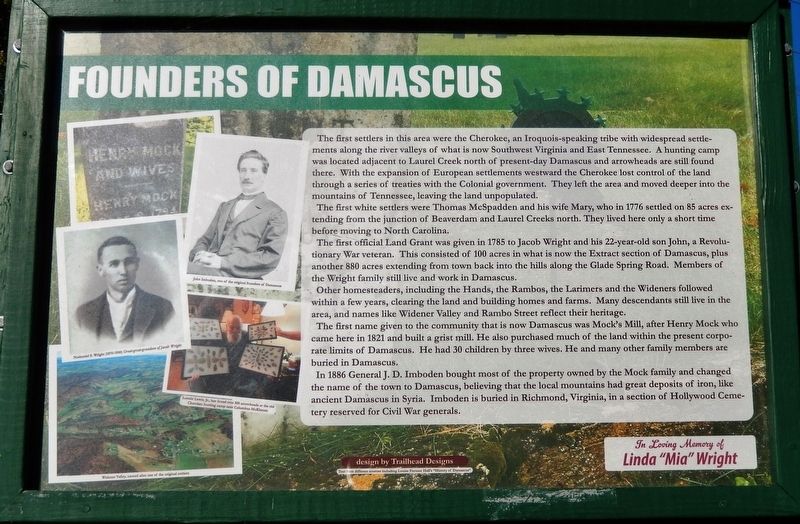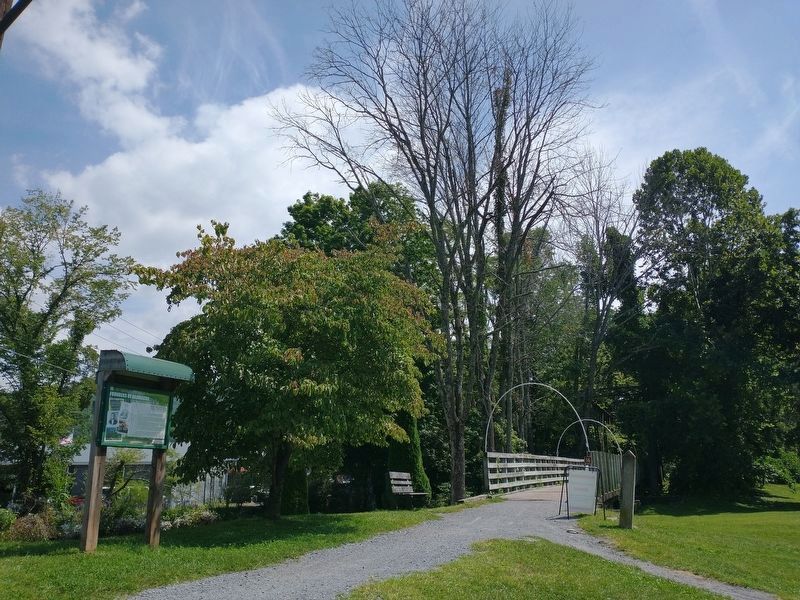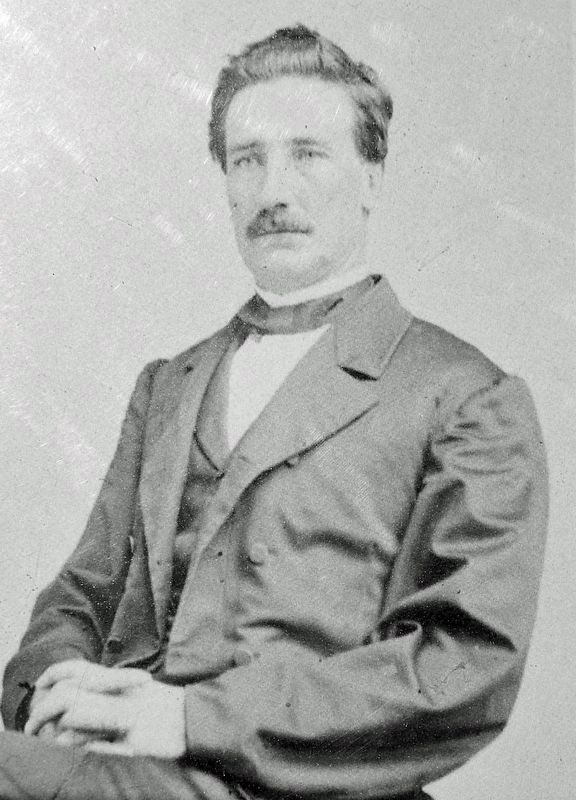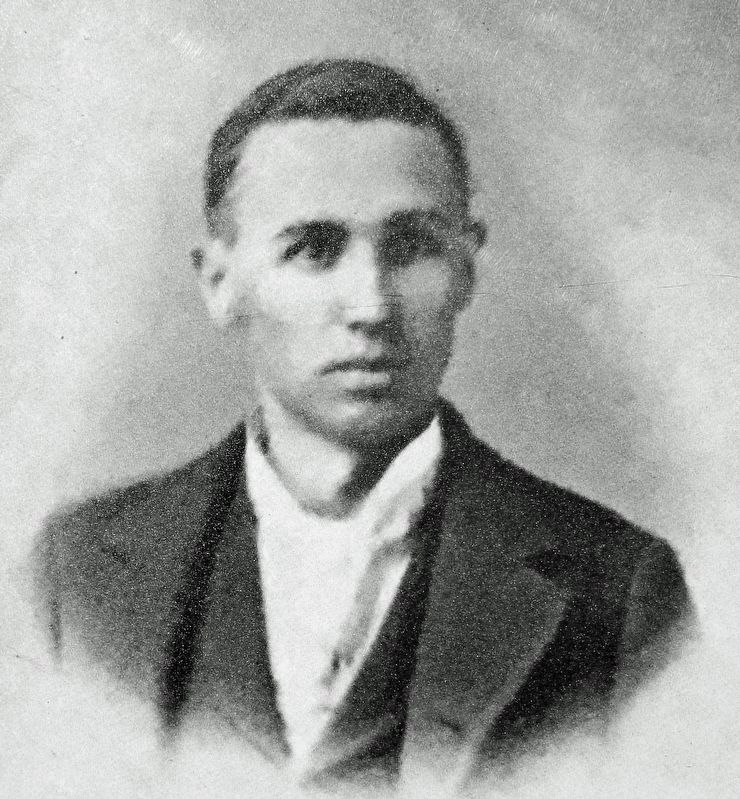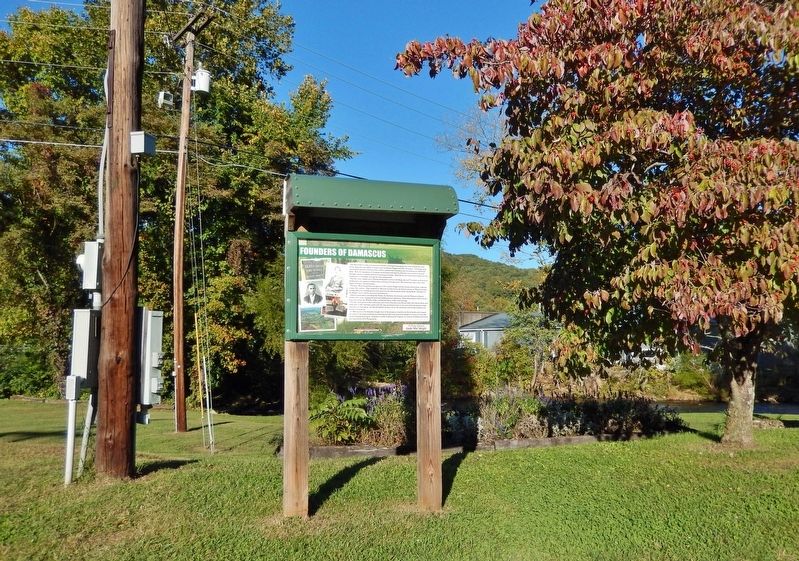Damascus in Washington County, Virginia — The American South (Mid-Atlantic)
Founders of Damascus
— The Damascus History Tour —
The first settlers in this area were the Cherokee, an Iroquois-speaking tribe with widespread settlements along the river valleys of what is now Southwest Virginia and East Tennessee. A hunting camp was located adjacent to Laurel Creek north of present-day Damascus and arrowheads are still found there. With the expansion of European settlements westward the Cherokee lost control of the land through a series of treaties with the Colonial government. They left the area and moved deeper into the mountains of Tennessee, leaving the land unpopulated.
The first white settlers were Thomas McSpadden and his wife Mary, who in 1776 settled on 85 acres extending from the junction of Beaverdam and Laurel Creeks north. They lived here only a short time before moving to North Carolina.
The first official Land Grant was given in 1785 to Jacob Wright and his 22-year-old son John, a Revolutionary War veteran. This consisted of 100 acres in what is now the Extract section of Damascus, plus another 880 acres extending from town back into the hills along the Glade Spring Road. Members of the Wright family still live and work in Damascus.
Other homesteaders, including the Hands, the Rambos, the Larimers and the Wideners followed within a few years, clearing the land and building homes and farms. Many descendants still live in the area, and names like Widener Valley and Rambo Street reflect their heritage.
The first name given to the community that is now Damascus was Mock's Mill, after Henry Mock who came here in 1821 and built a grist mill. He also purchased much of the land within the present corporate limits of Damascus. He had 30 children by three wives. He and many other family members are buried in Damascus.
In 1886 General J. D. Imboden bought most of the property owned by the Mock family and changed the name of the town to Damascus, believing that the local mountains had great deposits of iron, like the ancient Damascus in Syria. Imboden is buried in Richmond, Virginia, in a section of Hollywood Cemetery reserved for Civil War generals.
Text from different sources including Louise Fortune Hall’s “History of Damascus”
In Loving Memory of
Linda “Mia” Wright
[other photo captions]
• Lonnie Lewis, Jr., has found over 500 arrowheads at the old Cherokee hunting camp near Columbus McKinnon
• Widener Valley, named after one of the original settlers.
Erected by The Damascus History Tour.
Topics. This historical marker is listed in these topic lists: Cemeteries & Burial Sites • Native Americans • Settlements & Settlers • War, US Civil. A significant historical year for this entry is 1776.
Location. 36° 38.108′ N, 81° 47.503′ W. Marker is in Damascus, Virginia, in Washington County. Marker can be reached from South Beaver Dam Avenue just south of West Laurel Avenue (U.S. 58), on the left when traveling south. Marker is located in Damascus Town Park, beside the Virginia Creeper National Recreation Trail. Touch for map. Marker is at or near this postal address: 55775 Virginia Creeper National Recreation Trail, Damascus VA 24236, United States of America. Touch for directions.
Other nearby markers. At least 8 other markers are within walking distance of this marker. Damascus (a few steps from this marker); Laurel Avenue, The Main Street of Damascus (within shouting distance of this marker); Electricity Comes to Damascus (about 300 feet away, measured in a direct line); Damascus Presbyterian Church (about 600 feet away); Churches of Damascus (about 700 feet away); Damascus Old Mill (about 700 feet away); Water Tanks (approx. 0.2 miles away); Virginia Creeper Trail (approx. ¼ mile away). Touch for a list and map of all markers in Damascus.
Related markers. Click here for a list of markers that are related to this marker. The Damascus History Tour
Also see . . .
1. John Daniel Imboden.
American lawyer, Virginia state legislator, and a Confederate army general. During the American Civil War, he commanded an irregular cavalry force. In 1872 he published The Coal and Iron Resources of Virginia: Their Extent, Commercial Value, and Early Development Considered. Around 1875, he moved to southwestern Virginia where he hoped to mine coal and iron ore deposits. He founded the town of Damascus, Virginia, which became a lumber center in the late 19th and early 20th century. Imboden also participated in Confederate veterans activities and the Lost Cause movement. He published several articles and books about the Civil War.(Submitted on November 6, 2022, by Cosmos Mariner of Cape Canaveral, Florida.)
2. Brigadier General John Daniel Imboden.
Imboden entered service at the start of the war, serving first as commander of the Staunton Artillery at Harper's Ferry, after its initial capture. He fought at 1st Manassas, where he was wounded by a shell fragment. He then organized the Virginia Partisan Rangers. He commanded a brigade of cavalry under Jeb Stuart at Gettysburg. During the Confederate withdrawal after the battle, Lee charged Imboden with escorting the train of thousands of wounded back to Virginia. After a bout with typhoid in the fall of 1864, Imboden finished his wartime service performing prison duty in Aiken, South Carolina. After the war, Imboden practiced law in Richmond, Virginia, then spent his last years in the mining industry in Washington County.(Submitted on November 6, 2022, by Cosmos Mariner of Cape Canaveral, Florida.)
Credits. This page was last revised on February 2, 2023. It was originally submitted on November 5, 2022, by Cosmos Mariner of Cape Canaveral, Florida. This page has been viewed 480 times since then and 127 times this year. Photos: 1. submitted on November 6, 2022, by Cosmos Mariner of Cape Canaveral, Florida. 2. submitted on November 22, 2022, by Tom Bosse of Jefferson City, Tennessee. 3, 4, 5. submitted on November 6, 2022, by Cosmos Mariner of Cape Canaveral, Florida.
